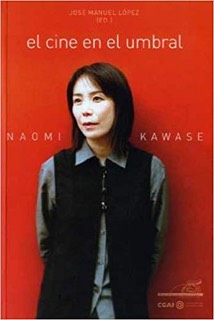
I hope everyone has been enjoying the new year of 2019. As some of you have noticed, I have tried to use the holiday break to update Tangemania, for instance by starting a new page on my Journal Articles (I’m not sure why I didn’t do that before), as well as adding more links on the site to my articles available on the Yale repository.
In the midst of doing that, I realized that I had some time ago uploaded my article on the film director and documentarist Kawase Naomi to the repository without announcing it here. Kawase-san and I go back a ways. I was one of the first to program her works at an international film festival (the New Asian Currents program of the 1995 Yamagata International Documentary Film Festival), and also interviewed her in 2000 for the YIDFF periodical, Documentary Box (see the interview here). We were close enough that my wife and I had her over for dinner at our house, and when the Infinity Film Festival in Italy did one of the first retrospectives of her work in Europe in 2002, I was invited as the outside expert, and did a day-long workshop with her. I sadly have not had much contact with her in the last decade, and some people I know grumble that as she has grown famous she has distanced herself from the people who helped her get started, but I still eagerly await her new films, even as I remain occasionally critical of them (like with Kitano, I tend to be a fan of the early work).
The article I wrote for the special catalog of the Infinity Festival focused on structures of repetition and thus of temporality in Kawase’s work. Against those who see circular temporalities of nature dominating her films, or a tension between circular and linear time, I focus on the importance of moments of rupture in her films. Her work, I argue, "exhibits an irresolvable but somehow necessary tension between repetition and rupture as equal and intertwined elements, one that not only complicates divisions such as circular/linear and natural/artificial, but makes her cinema as much a work of emptiness and destruction as it is of supplementation and regeneration.”
The article appeared in the catalog only in Italian. I had thought about publishing it in English, but held off because at the time I was thinking of writing a book on 1990s Japanese film and the piece would serve as one chapter. But after writing the Kitano book, my desire for writing on 1990s film ebbed and I moved on to other research, especially film theory. So the piece languished. Luckily, Jose Manuel Lopez, who was coordinating the Las Palmas Film Festival at the time, translated into Spanish a revised version I prepared for the catalog (photo above) of a Kawase retrospective in 2008.
Not really having the time to revisit and rewrite it now, I decided a few months ago to bundle the three versions—the English plus the Italian and Spanish translations—and upload it on to the Yale repository. (The English version is the one I prepared for the Spanish translation.) But I forgot to announce it here!
You can access the article here.
The bibliographic citations for the Italian and Spanish versions are as follows:
- “Ripetizione e rottura nei film di Kawase Naomi.” Kawase Naomi: i film i cinema. Ed. Maria Roberto Novielli. Torino: Effata Editrice, 2002. Pp. 30-37.
- “Repetición y ruptura en las peliculas de Naomi Kawase.” Naomi Kawase: el cine en el umbral. Ed. José Manuel López. Madrid: T & B Editores, 2008. Pp. 91-100.

